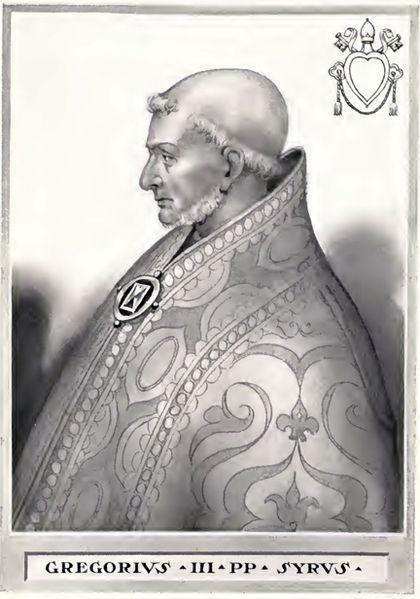Pope St. Gregory III- To protest the emperor, he paid special honor images and relics
Pope St. Gregory III was the son of a Syrian named John. The date of
his birth is not known. His reputation for learning and virtue was so
great that the Romans elected him pope by acclamation, when he was
accompanying the funeral procession of his predecessor, 11 February,
731. As he was not consecrated for more than a month after his election,
it is presumed that he waited for the confirmation of his election by
the exarch at Ravenna.
In the matter of Iconoclasm, he followed the
policy of his predecessor. He sent legates and letters to remonstrate
with the persecuting emperor, Leo III, and held two synods in Rome (731)
in which the image-breaking heresy was condemned. By way of a practical
protest against the emperor’s action he made it a point of paying
special honour to images and relics, giving particular attention to the
subject of St. Peter’s. Fragments of inscriptions, to be seen in the
crypts of the Vatican basilica, bear witness to this day of an oratory
he built therein, and of the special prayers he ordered to be there
recited.

The close of Gregory’s reign was troubled by the Lombards. Realizing the ambition which animated Liutprand, Gregory completed the restoration of the walls of Rome which had been begun by his predecessors, and bought back Gallese, a stronghold on the Flaminian Way, from Transamund, Duke of Spoleto, which helped to keep open the communications between Rome and Ravenna. In 739, Liutprand was again in arms. His troops ravaged the exarchate, and he himself marched south to bring to subjection his vassals, the Dukes of Spoleto and Benevento, and the Duchy of Rome. Transamund fled to Rome, and Gregory implored the aid of the great Frankish chief, Charles Martel. At length ambassadors from the viceroy (subregulus) of the Franks appeared in Rome (739). Their arrival, or the summer heats, brought a momentary peace. But in the following year, Liutprand again took the field. This time the Romans left their walls, and helped Transamund to recover Spoleto. When, however, he had recovered his duchy, he would not or could not comply with Gregory’s request, and endeavour to recover for the pope “the four cities of the Roman duchy which had been lost for his sake.” In the midst of all these wars and rumours of war, Gregory died, and was buried in the oratory of our Lady which he had himself built in St. Peter’s. He died in 741, but whether in November or December is not certain. It is however, on 28 November that he is commemorated in the Roman martyrology.
